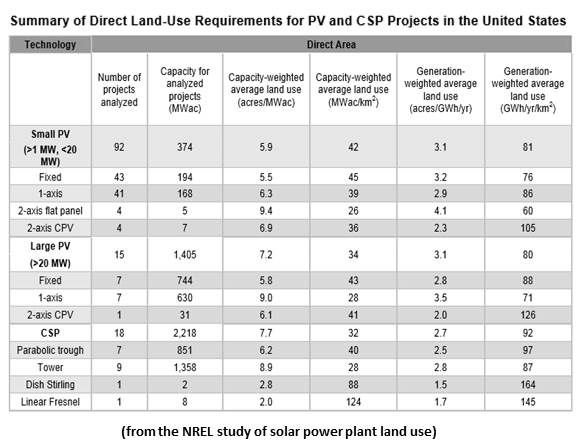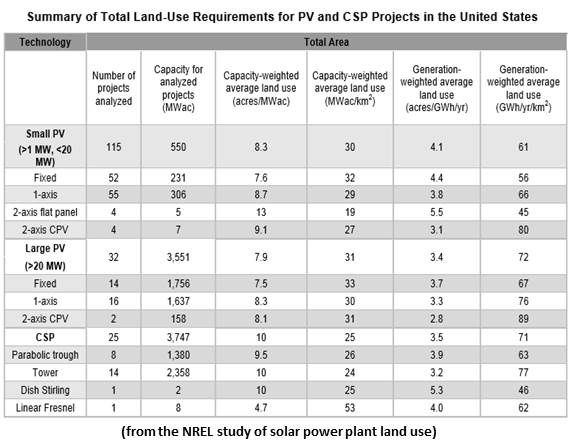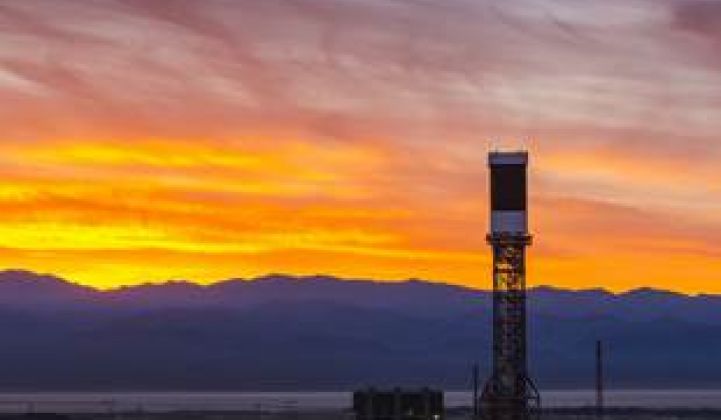As the price of photovoltaic solar levels out and the value of concentrating solar power's storage improves, it is possible that the price of land could become a decisive factor in a solar project’s overall energy costs. A new land-use analysis demonstrates the choice of technology could be crucial.
Researchers at NREL drew on acreage data from 72 percent of the 6.7 gigawatts of operating and under-construction photovoltaic and concentrating solar power solar capacity in 3Q 2012. The list of projects surveyed include those from major PV developers First Solar (FSLR) and SunPower (SPWR) as well as major CSP developers BrightSource Energy, SolarReserve and Abengoa.
The research team that produced the report Land-Use Requirements for Solar Power Plants in the United States used two land-use measurements. The total area was taken as the typically fenced offsite boundaries on blueprints. The direct-impact area was smaller. It included only the land on which there were solar arrays, access roads, substations, service buildings, and other infrastructure.
The most efficient total land use was the 2.8 acres per gigawatt-hour per year associated with two-axis CPV installations of more than 20 megawatts. The least efficient use of land was the 5.5 acres per gigawatt-hour per year associated with two-axis flat-panel PV projects of less than 20 megawatts.
The most efficient direct land use was the 1.5 acres per gigawatt-hour per year for dish Stirling CSP technology. The least efficient was, again, two-axis flat-panel PV projects of less than 20 megawatts, with 4.1 acres per gigawatt-hour per year.
The caveat -- and it is important -- is that only one dish Stirling project, from Tessera Solar, was analyzed. And only six CPV installations, including those from Tenaska and Cogentrix, were analyzed. Four of the CPV projects were less than 20 megawatts and only two were over 20 megawatts. Other relevant findings in the analysis included:
- Nine tower projects analyzed for direct land use came in at 2.8 acres per gigawatt-hour per year and seven parabolic trough CSP projects used 2.5 acres per gigawatt-hour per year, both better than the 43 smaller fixed PV projects’ 3.2 acres per gigawatt-hour per year and the 41 smaller single-axis 2.9 acres per gigawatt-hour per year.
- Fourteen tower projects analyzed for total land use came in at 3.2 acres per gigawatt-hour per year and eight parabolic trough projects used 3.9 acres per gigawatt-hour per year. The 52 smaller fixed PV projects used 4.4 acres per gigawatt-hour per year and 55 smaller single-axis PV projects used 3.8 acres per gigawatt-hour per year.
Larger PV projects, though currently falling out of favor with utility-scale solar developers and financiers, showed improved direct and total land use.
- Seven 20-megawatt-plus fixed and seven single-axis PV projects were analyzed. Fixed came in at 2.8 acres per gigawatt-hour per year in direct land use and single axis used 3.5 acres per gigawatt-hour per year.
- Fourteen 20-megawatt-plus fixed PV projects used 3.7 acres per gigawatt-hour per year in total land and sixteen 20-megawatt-plus single-axis projects used 3.3 acres per gigawatt-hour per year.
The smart use of infrastructure in PV projects had more to do with efficient land use than module efficiency, according to lead researcher Sean Ong.
The value of the numbers and conclusions, the study acknowledged, was limited by relatively small sample sizes, and the best quality data was not always available for analysis. Often, the researchers could not get data from developers and were forced to use third-party sources.
Also, over 26 gigawatts of utility-scale PV and CSP projects were in development in February 2013. “Owing to the rapid evolution of solar technologies, as well as land-use practices and regulations,” the NREL study noted, “the results reported here reflect past performance and not necessarily future trends.”





